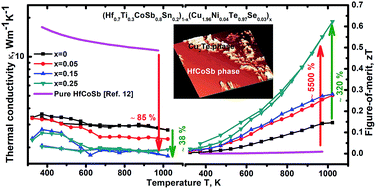Enhancing the thermoelectric performance of a p-type half-Heusler alloy, HfCoSb by incorporation of a band-matched chalcogenide, Cu2Te
Abstract
The figure-of-merit of p-type half-Heusler alloys is low due to high effective charge carrier mass and concentration. To offset this decrease a composite strategy has been adopted wherein a modified HfCoSb alloy and Cu2Te based chalcogenide have been selected as two p-type components. The composites with a maximum of 25 wt% chalcogenide have been synthesized by spark plasma sintering. The components retain their structure and composition with the half-Heusler alloy having a cubic F![[4 with combining macron]](https://www.rsc.org/images/entities/char_0034_0304.gif) 3m structure while the chalcogenide has a predominantly hexagonal structure. The power factor of the 25 wt% composite increases to 1.2 mW m−1 K−2 with a concurrent decrease in the thermal conductivity to 1.8 W m−1 K−1 compared to 0.4 W m−1 K−2 and 2.8 W m−1 K−1 for the half-Heusler alloy, respectively. This results in the composite exhibiting the highest figure-of-merit of 0.65 compared to 0.15 for the half-Heusler alloy at 1023 K, an increase of 320%. The leg power output increases from 0.3 W cm−2 to 0.65 W cm−2 while the efficiency increases from 1.5% to 5.5% at this temperature. These enhancements are due to band matching and bending at the half-Heusler/chalcogendie interfaces which facilitates charge transport while blocking the phonons.
3m structure while the chalcogenide has a predominantly hexagonal structure. The power factor of the 25 wt% composite increases to 1.2 mW m−1 K−2 with a concurrent decrease in the thermal conductivity to 1.8 W m−1 K−1 compared to 0.4 W m−1 K−2 and 2.8 W m−1 K−1 for the half-Heusler alloy, respectively. This results in the composite exhibiting the highest figure-of-merit of 0.65 compared to 0.15 for the half-Heusler alloy at 1023 K, an increase of 320%. The leg power output increases from 0.3 W cm−2 to 0.65 W cm−2 while the efficiency increases from 1.5% to 5.5% at this temperature. These enhancements are due to band matching and bending at the half-Heusler/chalcogendie interfaces which facilitates charge transport while blocking the phonons.



 Please wait while we load your content...
Please wait while we load your content...